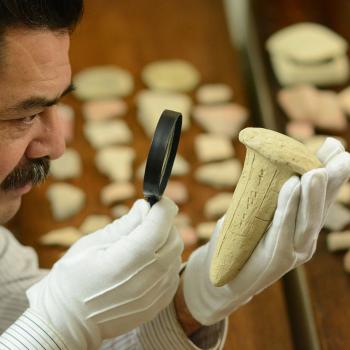Switching from one religion to another happens quite a bit in the United States. In 2008 the Pew Forum released its U.S. Religious Landscape Survey, and followed this up in 2009 with a report titled “Faith in Flux: Changes in Religious Affiliation in the U.S.” This report was somewhat surprising in that it revealed a greater fluidity in religious affiliation than had previously been recognized. In the 2007 survey, 28% of American adults had made transitions involving religious affiliation. However, the findings from the 2009 report “suggest that previous estimates actually may have understated the amount of religious change taking place in the U.S.” Respondents indicated that they had left their previous religion for a variety of reasons, but disenchantment with religious institutions and religious people were significant reasons cited.
Many practitioners of other faith traditions with whom I interact formerly identified as Christians. In one sense, it is not surprising, as Christianity is still the dominant faith tradition in the United States (However, it should be noted that there is an increasing number of religions seeking converts). In another sense, it is surprising to find people leaving Christianity, as I am deeply satisfied in my faith journey with Jesus Christ. Those of us who are quite content in our Christian faith may ask: how could anyone leave Jesus?
To be fair, some of the practitioners of other faith traditions will be quick to say that they have not abandoned Jesus, but simply reconstrued their relationship with him. Yet others will renounce the Christian faith in its entirety. One of the issues that arises in this context is how to transition well from one faith tradition to another, whether Christian, Buddhist, Muslim, Pagan, etc.
Sometimes the most antagonistic people toward Christianity are those who have left it. The same goes for people who have left other faith traditions due to various factors. It is hoped that wherever we come from and where we go in our faith journey we come to terms with our departures and pursue healthy closure. Reactionary approaches to various faith traditions do not account for them in all their complexity and depth but reduce them to anecdotes no matter how significant.
Case in point, one Buddhist leader told my world religions class this week that she experienced a great deal of pain and antagonism when she first left the Christian faith. Due to growth as a Buddhist and further interaction with various Christians, she came to the realization that it was not Christianity as such that caused negative emotion and hostility, but family of origin wounds. Those family members happen to be Christian. Through sustained engagement with other Christians, this Buddhist leader has come to understand herself better, as well as Christianity. She has transitioned well from Christianity to Buddhism in that she has not faulted Christianity for problems not of its own making, but some of its adherents. A former Christian now Pagan leader shared a similar journey with my world religions class.
Many people have made this faith transition journey. It is often painful and challenging. It involves not only leaving particular beliefs and a worldview behind, but also a sense of personal identity, family and other social connections as well. These transitions can strain families and friendships, sometimes to the breaking point. Those who remain in a religious tradition can often unintentionally exacerbate this transition process, accusing those making the journey of being weak, having never really been committed, perhaps even giving in to demonic deception (depending on the religious tradition of course). Does the migration from one religion to another really have to be this difficult and jarring? Is it possible to make the transition less painful, even while hoping those who depart their original faith might return to it down the road?
Many conservative Christians will struggle over the claim that one can transition well from the Christian faith to another faith. I understand that given our monotheistic orientation one can never really transition well, but only poorly. That said, if someone is going to leave the Christian heritage, wouldn’t we want them to leave without antagonism toward our tradition? Moreover, would not the removal of such antagonism allow for a person to become more keenly aware of authentic Christian faith rather than caricatures? And could not such growing awareness make possible the return to a vital relationship with Jesus as Savior and Lord?
My colleague John Morehead has developed materials that help people transition well from one faith tradition to another. The focus of these materials is on Latter-day Saints who have become historic orthodox Christians. Just as Mormons have recognized the need to create resources to assist those coming from more traditional forms of Christianity into Mormonism, Evangelicals like Morehead have recognized the need to craft sources to assist those moving from Mormonism to traditional Christian churches.
In response to the interests of pastors along the Wasatch Front in Utah, and having seen firsthand the struggles of former Mormon immigrants for many years, Morehead made the decision to produce this guide. Seeking to account for their stories filled with difficulties, he put himself in their shoes in order to try and understand their needs in the transition process. Rather than starting from Evangelical assumptions, he started from those of the people in transition, drawing upon the metaphor of immigration and the facilitation of a journey. This meant creating a resource that began with pain and trauma. Once the pain and trauma were addressed and a healthier emotional foundation was in place, he then imparted a fresh understanding of Christian doctrine and worldview. But even that was done differently. Taking his cues from missions and the need to frame a message for a different culture, Morehead drew upon the LDS narrative framework and then communicated orthodox Christian doctrine in ways that answered more familiar Mormon questions.
The result was a video and workbook resource called Transitions: The Mormon Migration from Religion to Relationship. It has been used by individuals and in small groups in churches throughout the U.S. Transitions is not the first resource created by Evangelicals to assist former Mormons, but it is the first resource produced from the perspective of the person making the transition journey. Therefore, Transitions makes a unique contribution to resources by Evangelicals addressing religious disaffiliation and reaffiliation in regards to Mormonism. You can hear the stories of Mormons making the faith migration and how the Transitions resource met their needs here at this link.
The same needs and approach would apply to traditional Christians who become Latter-day Saints. While Morehead and I would certainly grieve over the decision some would make to abandon historic, orthodox Christianity, we might also ask how the journey can be made easier to reduce trauma and antagonism. If people are going to leave, how can we engage them redemptively, keeping open the door of relationship and growing in our own understanding? Who knows, those who leave the faith may return someday? Yet, how can they if we have shut the door in their faces? Still, whether they return, we should care for them and treat them with respect. Wouldn’t we wish that people of other paths will care and treat with respect those who depart their own faith traditions to follow Jesus?













